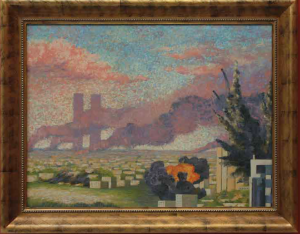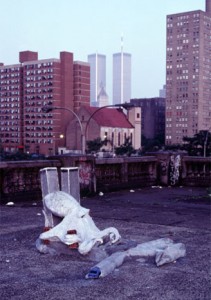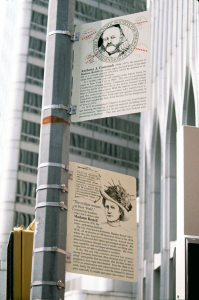Still Waiting for the End of Irony… *
Dual testimonials to top-down government arrogance is how artists and activists viewed the World Trade Center towers in the late 70s. First proposed during World War II by Chase Manhattan’s David Rockefeller the priapic complex was finally constructed some three decades later on a site once crammed with small electronic resale merchants, many of Syrian origin. I moved to the Lower East Side in 1977 just after the massive blackout and while the city was still in the midst of a double-dip recession that left large parts of its infrastructure in tatters. Hovering over demolished urban blocks were the two towers, their enormous scale and minimal façades at once a means of orientation, and an improbable artifact strangely disconnected from the rest of the downtown skyline. Visual alienation is key here because what was meant to signal to the gods of global capital that Manhattan is still the center of the monetary universe, was also perceived as an omen of gentrification soon to replace a blue-collar workforce with “no collars,” to borrow a term Andrew Ross coined for the seemingly déclassé armies of the emergent techno-creative class.
Ironic is therefore the correct way to describe the double metamorphoses of a contentious monument to money, first into the “Lusitania” of the Iraq War, and then again into a place of reflection whose precise focus nevertheless remains intentionally imprecise. As curator and critic Olga Kopenkina puts it “the memorial in the city center is not only supposed to remind us about destruction of an important commercial area, it is a mode of survival, a lever with which capitalism creates a new platform with which to leap forward and capture a bigger territory for the purpose of not only re-building destroyed parts, but creating an entire landscape that unfolds in both physical and psychological space.”[The entire text is here: Olga Kopenkina on 9/11]
To put it another way: goodbye crater, hello new affective space in the form of heart-rending mausoleum, or monument to national willpower, or secularized tower for peace? (Or is it merely a refurbished beacon for calling forth the deities of global finance all over again?) In any case, just as the militarization of the WTC followed its actual dematerialization, the site’s de-militarization seems to have been made possible by its architectural resurrection.
II
In early October, 2001 I first stood at the site of the savage attacks that immediately came to be known as ground zero; perhaps the most ubiquitous of several military terms that –along with asymmetrical warfare and surgical strike- are now part of our everyday language in the United States (and as theorist Gene Ray urged this moment of terminological linking was a lost opportunity for national self-reflection). Though still chaotic and unprocessed just enough time had passed to absorb some of the immediate shock. What I remember most from that day were several National Guard soldiers who forbid those of us in the crowd from taking pictures, and in one case even confiscating someone’s roll of film (non-digital photography was still in common use at the time). Asking about this situation one soldier explained to me this was an official policy, it was after all a crime scene, though I wonder now if the enthusiasm of this ban was not just these particular guardsmen acting independently (for certainly there is no lack of WTC wreckage images, and a google image search using the terms “world trade ruin” returns over five million hits).
Perhaps at that moment, at that place, and for these guardsmen, the debris field may have appeared too ethereal to be captured by a mere photograph. I seem to actually recall one soldier who brandished a strip of exposed35 mm film from her ammo belt like a semaphore of deterrence, but I am no longer certain. Whether official, or informal, this diligent prohibition against picture taking actually served to underscore the singularity of a rare communal encounter in which, eyes pointed in one direction, we collectively did not see something.
Then came the souvenir torrent, the t-shirts, posters, children’s collages, but also the American flags that appeared like displaced tourniquets everywhere following 911. Less noticed was the rise of a another un-seeable colossus, a multi-billion dollar surveillance industry seeded by a secreted stimulus package (recently taken up by Washington Post reporters Dana Priest and William M. Arken) And what about the CSI generation’s preoccupation not with who done it, or why, but with the scrupulous minutia of “how”? Furthermore, the WTC event was marked by appearances and vanishings and returns that make it an all but impossible subject for representation. Nevertheless, I offer here a different set of encounters and responses to our national wound: a collection of six art works that, in different ways, complicate the sweeping prognosis made on 911 that irony and postmodernism are henceforth ‘dead.’ * Significantly, irony is, or was, merely a starting point for many of these pieces, even as I suspect none of the artists who created them would ever be fully comfortable with the description “post-modernist.” *
III
A decade after the World Trade Center was completed artist Rebecca Howland created a sculpt-metal version of the towers merged with a huge, flailing octopus. The work was installed out of doors, on the Williamsburg Bridge in 1983, fully within view of the twin towers. At the time Howland was associated with the independent cultural center ABC No Rio, itself the offspring of a squatter action known as The Real Estate Show.
Ten years later the group REPOhistory installed a set of metal street markers on a lamppost outside the south tower. The signs were part of the group’s Lower Manhattan Sign Project and were researched and designed by Janet Koenig and Lisa Maya Knauer (below left). The specific historical site they “repossessed” was the office of the highly successful 19th Century abortionist Ann Trow, AKA Madame Restell. The second metal panel showed US Postal Inspector Anthony Comstock who assailed Restell and other proponents of women’s choice through anti-obscenity laws that socialist playwright George Bernard Shaw once lampooned as “Comstockery.” Abortion was eventually outlawed and by 1873 The Comstock Laws forbid distributing information about birth control. Awaiting arrest Restell took her own life. REPOhistory’s project was created in 1992 at a moment when Roe V. Wade was under direct attack by the senior George Bush’s neo-conservative Supreme Court appointees David Souter and Clarence Thomas. Several months later in 1993 Koenig and Knauer’s sign was demolished by a truck-bomb detonated inside the WTC’s underground garage.
Artist Michael Richards collaborated with REPOhistory in 1992 on the construction of a large gallery installation at Artists’ Space entitled Choice Histories: Framing Abortion. Richards’s contribution was in one section of the project dedicated to issues of race and class. Later Richards began sculpting a series of works about flight including the self-portrait Tar Baby vs. St. Sebastian in which more than a dozen miniature aircraft project from his realistic cast body like arrows. The artist died during the attacks of September 11th 2001 while inside a studio space in Tower One operated by the Lower Manhattan Cultural Council.

Kill the Chickens to Scare the Monkeys is a Chinese proverb. It is also the title of another REPOhistory alumni Todd Ayoung’s visceral photomontage about which the artist explains “some of us are chickens and some are flies sacrificed to keep the monkeys (also us) in their place after 9/11.” Ayoung’s work refers to what our leaders describe as a state of unremitting, asymmetrical warfare in which national security concerns are frequently cited as a reason to suppress civil rights, conceal information previously considered publicly accessible, and for gathering and processing images and personal information about a population snared in an unceasing state of networked catastrophe.
Not everyone took this “code orange” state of continuous emergency in stride. Between 2004 and 2007 a group of artists and legal activists known as Visible Collective sought to visualize the stigmatization and detention of a still unknown number of Islamic, Middle Eastern, or North African people inside the country targeted for suspension of habeas corpus and mass cataloging, as well as the virtual disappearance of many others who were “renditioned” to “extra-juridical” zones within Pakistan and Syria and other places where human rights do not stand in the way of extreme interrogation methods (or as we have seen over the past year, places where calls for democracy are greeted with state organized brutality, including Libya – according to the Guardian newspaper the CIA and MI6 collaborated with recently ousted president Muammar Gaddafi following the 911 attacks in processing terror suspects).
 Pedro Lasch, Phantom Limb, Gaza, 2011
Pedro Lasch, Phantom Limb, Gaza, 2011
Just last week I visited Pedro Lasch’s exhibition at Stephan Stoyanov Gallery http://www.stephanstoyanovgallery.com/ on Orchard Street (the official opening is September 7). Known more for his conceptually-based museum interventions such as Black Mirror, Lasch has spent the last ten years producing a series of meticulous oil paintings in which monolithic twin tower’s appear like phantom limbs around the world including Budapest, Kabul, and perhaps most effectively in Gaza as airstrikes sprout pointillist smoke trails that pay unexpected homage to Seurat. (To propose other locations for the WTC apparitions log on to Twin Towers Go Global (TTGG)
IV
Becky Howland’s trade center cephalopod; REPOhistory’s bomb-blasted street sign; Michael Richard’s uncanny plane-pierced portrait; Todd Ayoung’s prickly eco-trauma; the tenacity of Visible Collective; and Pedro Lasch’s painted phantoms offer a different series of stations from which to observe the disappearance and reappearance of events as we wait and wait for the final melting-away of an irony that I suspect we almost certainly could not bear to live without…not yet.
_____________________________________________
* For a commentary on this phenomena made at the time by journalist David Beersby see: “Irony is Dead! Long live irony,” in Salon.com written two weeks and two days after the 911 attacks: http://www.salon.com/life/feature/2001/09/25/irony_lives/print.html


